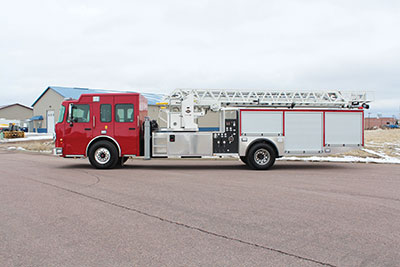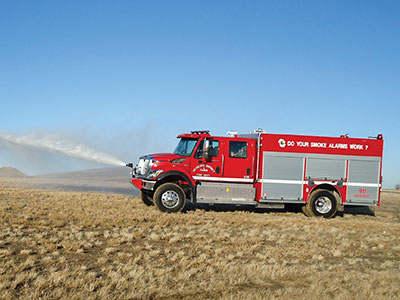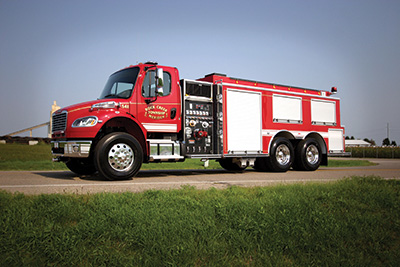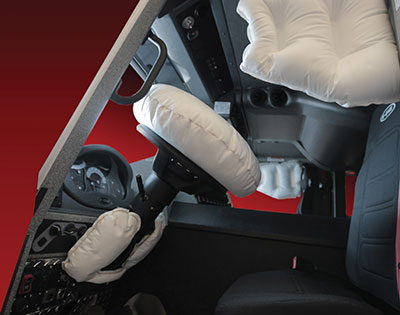
Equipment
Techsmart: Driving Change
With budgets cuts constantly looming, fire departments need to find efficiencies and make compromises – thus the old adage, doing more with less, seems all the more relevant.
September 10, 2013
By Olivia D’Orazio
With budgets cuts constantly looming, fire departments need to find efficiencies and make compromises – thus the old adage, doing more with less, seems all the more relevant.
 |
|
| Spartan ERV’s multi-purpose aerial-pumper-ladder truck features a 20-metre (65-foot) ladder, a maximum 1,500-GPM pump, and 11 cubic metres (400 cubic feet) of compartment space – all for $425,000 or less. Photo courtesy Spartan ERV
|
As neighbourhoods become diverse landscapes, departments are being forced to decide between new fire apparatuses that are becoming more and more necessary – a new condo building in town may make a ladder truck a good investment, but your pumper is getting old. . .
Or maybe your existing trucks are having trouble traversing the increasingly cluttered city streets – new bike lanes, separated streetcar lanes, bigger garbage bins, and what seems like a never-ending onslaught of people crowded on street corners.
Several truck makers are improving their products so that departments don’t have to compromise their communities’ safety.
Fort Garry Fire Trucks’ newly designed Duster series of trucks have a shorter wheel base, which makes it easier to manoeuvre them around tight spaces. This ease can translate to faster response times.
“Streets today can get congested very quickly,” explains Chris Dennis, the chief mechanical officer for Vaughan Fire & Rescue Services in Ontario, and columnist for Fire Fighting in Canada magazine.
“[A truck’s manoeuvrability] would definitely impact response times. In some cases, you really need to think about the route you take to a scene.
 |
|
| Fort Garry’s Duster line of trucks features a short wheelbase, making it easier for the truck to manoeuvre around tight spaces. This ease can translate to faster response times. Photo courtesy fgft |
“If the truck has a longer wheel base, and you know there are always cars parked along that street, the truck may not be able to make the turn, but a truck with a shorter wheel base would – that would decrease the response time.”
The Duster pumper truck, for example, retains all the functions of a larger pumper truck, including a 1,000-gallon tank, a 1250 Darley PTO pump, seven cubic metres (252 cubic feet) of equipment space and a two-and-a-half cubic metre (92 cubic foot) hose bed, but offers a shorter wheel base that enables it to better traverse through narrow landscapes.
“It’s a good bush truck, too,” says Fort Garry president Rick Suche.
“It gives [fire departments] a much better turning radius, so if they need to go through narrow bush roads, they can get [to the fire] quicker. There’s also a low centre of gravity so [the truck] is more stable on off-road situations.”
Meanwhile, Spartan ERV has developed a pumper/aerial/rescue truck, all in one apparatus. The multi-use truck features a 20-metre (65-foot) ladder, a maximum 1,500-GPM pump, and 11 cubic metres (400 cubic feet) of compartment space – all for $425,000 or less.
“Any elevated aerial device makes a great master stream,” Dennis explains. “It’s also a wonderful piece of equipment for reaching rooftops and ventilation.
“If it’s a rural operation, though, you’d want a big water tank . . . So, you need to think about the operation [and] need to know that you have the best truck for the job.”
The aerial features on the Spartan truck include a three-section 20-metre (65-foot) ladder and a 1,000-GPM waterway. The rescue features include 11 cubic metres (400 cubic feet) of storage with LED compartment lighting and custom tool mounting, while the pumper includes either a 300-gallon or a 500-gallon water tank, a 1,250-GPM pump, as well as NFPA-compliant ground ladders.
“In the U.S., there are over 24,000 fire departments that do not have an aerial device, and the primary reason is cost,” explained Russell Chick, corporate director of marketing for Spartan ERV, in an e-mail.
“Pumpers are the baseline apparatus for every fire department. The [Spartan truck] . . . is a versatile multi-function pumper. It is . . . ideally suited for today’s price-sensitive marketplace.”
For more information on Fort Garry’s pumper line, visit www.fgft.com , and for more information on Spartan ERV’s multi-function truck, visit www.spartanerv.com .
Light-weight and rust-proof
Many truck manufacturers aren’t re-inventing the wheel so much as they’re improving it.
 |
|
| Midwest Fire has developed a new body for some of its pumpers and tankers that is made entirely of polypropylene, a synthetic plastic-based material. As a result, the truck is lightweight, rust-proof and corrosion-proof. Photo courtesy Midwest Fire |
Midwest Fire, for example, has developed a new body for some of its pumpers and tankers that is made entirely of polypropylene, a synthetic plastic-based material.
As a result the truck is lightweight, rust-proof and corrosion-proof. The truck also comes with a lifetime tank and body warranty, and a lower upfront cost than traditional aluminum and stainless steel trucks.
“The cost of materials and the environment have really impacted how fire trucks are being built,” says Chris Dennis, the chief mechanical officer for Vaughan Fire & Rescue Services in Ontario.
Dennis says that, while departments need to consider several things when purchasing a truck, such as environmental friendliness or the types of incidents to which the department responds, the cost of the truck is one of the bigger considerations.
However, Erin Schneekloth of Midwest Fire says the rust- and corrosion-proof nature of Midwest Fire’s All-POLY line of trucks, paired with the company’s lifetime warranty, minimize the cost of the truck over time.
“It can perform no different from any other truck or standard metal-body truck that we could build,” Schneekloth says.
“It would outperform [the other trucks], with the lifetime warranty.”
For more on Midwest Fire’s all-polypropylene truck, visit www.midwestfire.com .
Guarding the protectors
Safety is an important consideration in every part of the fire service – from operations to equipment and everything in between. E-One is taking apparatus safety one step further with its ProTech system.
 |
|
| E-One’s ProTech system includes a variety of new and improved safety features, including airbags on the steering wheel and officer knee areas, pictured above.
|
In terms of accident prevention, the system incorporates a collision warning and mitigation system that uses a radar system to detect a possible collision and warn the driver, electronic stability control that offers support during evasive driving manoeuvres, and 360-degree cameras and backup sensors.
The protection aspects of the system include several airbags: on the steering wheel and in the driver and officer knee areas. The system also involves a cab that was designed like a roll cage to mitigate damage and injuries in the event of an accident.
“The fire trucks today are finally not only meeting the standards set by the automotive engineer – airbags and seatbelt restraints – but are exceeding safety features,” Dennis says.
For more information on E-One’s ProTech system, visit www.e-one.com.
Print this page